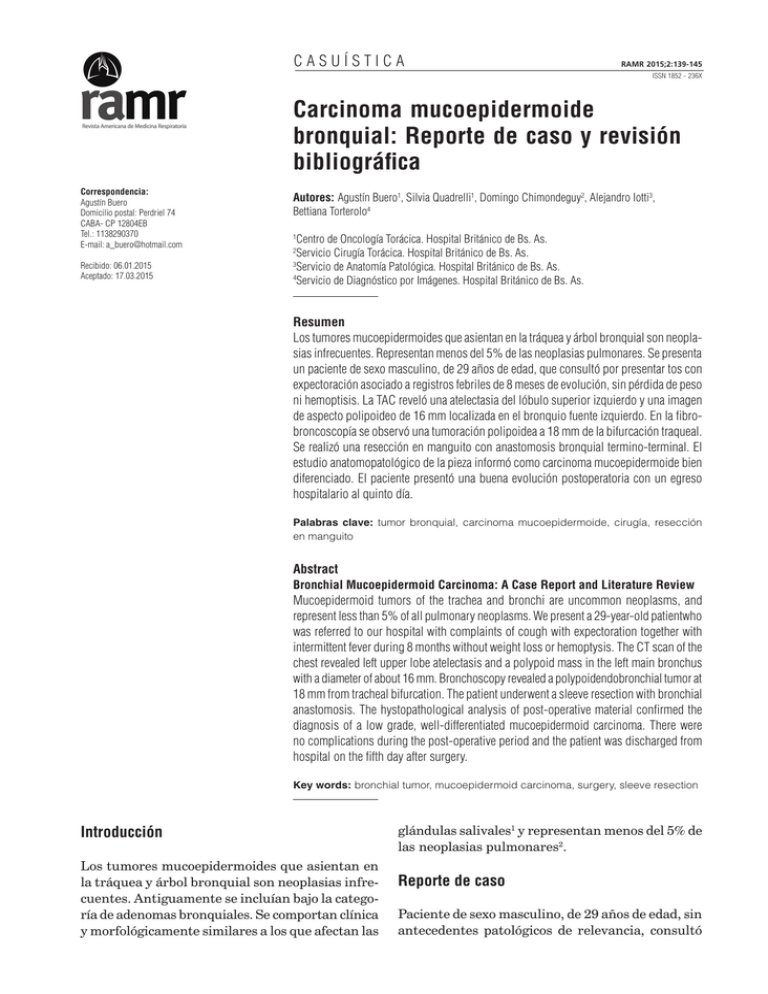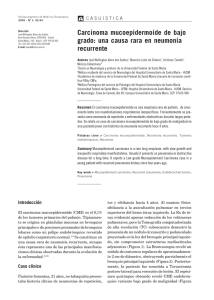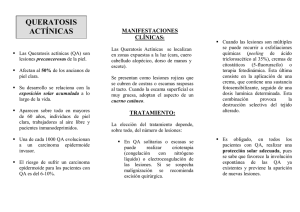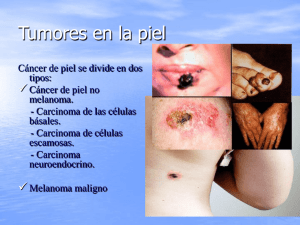Carcinoma mucoepidermoide bronquial: Reporte de caso y revisión bibliográfica
Anuncio

Carcinoma mucoepidermoide CASUÍSTICA 139 RAMR 2015;2:139-145 ISSN 1852 - 236X Carcinoma mucoepidermoide bronquial: Reporte de caso y revisión bibliográfica Correspondencia: Agustín Buero Domicilio postal: Perdriel 74 CABA- CP 12804EB Tel.: 1138290370 E-mail: [email protected] Recibido: 06.01.2015 Aceptado: 17.03.2015 Autores: Agustín Buero1, Silvia Quadrelli1, Domingo Chimondeguy2, Alejandro Iotti3, Bettiana Torterolo4 Centro de Oncología Torácica. Hospital Británico de Bs. As. Servicio Cirugía Torácica. Hospital Británico de Bs. As. 3 Servicio de Anatomía Patológica. Hospital Británico de Bs. As. 4 Servicio de Diagnóstico por Imágenes. Hospital Británico de Bs. As. 1 2 Resumen Los tumores mucoepidermoides que asientan en la tráquea y árbol bronquial son neoplasias infrecuentes. Representan menos del 5% de las neoplasias pulmonares. Se presenta un paciente de sexo masculino, de 29 años de edad, que consultó por presentar tos con expectoración asociado a registros febriles de 8 meses de evolución, sin pérdida de peso ni hemoptisis. La TAC reveló una atelectasia del lóbulo superior izquierdo y una imagen de aspecto polipoideo de 16 mm localizada en el bronquio fuente izquierdo. En la fibrobroncoscopía se observó una tumoración polipoidea a 18 mm de la bifurcación traqueal. Se realizó una resección en manguito con anastomosis bronquial termino-terminal. El estudio anatomopatológico de la pieza informó como carcinoma mucoepidermoide bien diferenciado. El paciente presentó una buena evolución postoperatoria con un egreso hospitalario al quinto día. Palabras clave: tumor bronquial, carcinoma mucoepidermoide, cirugía, resección en manguito Abstract Bronchial Mucoepidermoid Carcinoma: A Case Report and Literature Review Mucoepidermoid tumors of the trachea and bronchi are uncommon neoplasms, and represent less than 5% of all pulmonary neoplasms. We present a 29-year-old patientwho was referred to our hospital with complaints of cough with expectoration together with intermittent fever during 8 months without weight loss or hemoptysis. The CT scan of the chest revealed left upper lobe atelectasis and a polypoid mass in the left main bronchus with a diameter of about 16 mm. Bronchoscopy revealed a polypoidendobronchial tumor at 18 mm from tracheal bifurcation. The patient underwent a sleeve resection with bronchial anastomosis. The hystopathological analysis of post-operative material confirmed the diagnosis of a low grade, well-differentiated mucoepidermoid carcinoma. There were no complications during the post-operative period and the patient was discharged from hospital on the fifth day after surgery. Key words: bronchial tumor, mucoepidermoid carcinoma, surgery, sleeve resection Introducción Los tumores mucoepidermoides que asientan en la tráquea y árbol bronquial son neoplasias infrecuentes. Antiguamente se incluían bajo la categoría de adenomas bronquiales. Se comportan clínica y morfológicamente similares a los que afectan las glándulas salivales1 y representan menos del 5% de las neoplasias pulmonares2. Reporte de caso Paciente de sexo masculino, de 29 años de edad, sin antecedentes patológicos de relevancia, consultó 140 Revista Americana de Medicina Respiratoria por presentar tos con expectoración asociado a registros febriles de 8 meses de evolución. No refirió pérdida de peso ni hemoptisis. Al examen físico presentaba disminución de los ruidos respiratorios y de las vibraciones vocales asociados a sibilancias en el hemi-tórax izquierdo. En la radiografía de tórax se observó una pérdida de volumen a nivel del campo pulmonar superior izquierdo (Figura 1A). La TAC reveló una atelectasia del lóbulo superior izquierdo y una imagen de aspecto polipoideo de 16mm localizada en el bronquio fuente izquierdo (Figura 1B-C). La fibrobroncoscopía mostró una tumoración polipoidea en el bronquio fuente izquierdo a 18mm de la bifurcación traqueal (Figura 2A). La misma obstruía por completo la luz del bronquio. Al sospechar que se trataba de un tumor carcinoide, se decidió no tomar biopsias ya que el resultado de la misma no iba a modificar la conducta quirúrgica. Se realizó una resección en manguito con anastomosis bronquial termino-terminal. El estudio anatomopatológico de la pieza informó como carcinoma mucoepidermoide bien diferenciado de bajo grado de 2 × 1.5 cm (Figura 2B-C-D). La inmunomarcación reveló positividad para p53, citoqueratina AE1-AE3, CEA y un Ki67 del 3%. Los márgenes se encontraban libres de enfermedad. El paciente presentó una buena evolución postoperatoria con un egreso hospitalario al quinto día. Vol 15 Nº 2 - Junio 2015 Discusión Los carcinomas mucoepidermoides (MECs) que afectan a los bronquios son habitualmente neoplasias bien circunscriptas cubiertas por mucosa bronquial normal que se caracterizan por invasión local con baja diseminación a distancia3. Los MECs de BAJO GRADO (como el caso que se presenta) deben diferenciarse de los MECs de alto grado y carcinomas adenoescamosos, por ser estos dos últimos de peor pronóstico y tratamiento diferente4. Los MECs se originan en las glándulas bronquiales. El de bajo grado se localiza en el centro de las mismas y tiene características histológicas similares a las glándulas salivares contiguas con mezcla de glándulas mucinosas y células escamosas con o sin atipia. Si bien los de alto grado son más difíciles de diferenciar de los carcinomas adenoescamosos, estos últimos presentan queratinización mientras que en los de alto grado está ausente, así como rara vez presentan carcinoma in situ. El tratamiento quirúrgico empleado para los MECs es similar al que se realiza en el cáncer de pulmón5. Como alternativa quirúrgica se puede realizar una lobectomía, una resección en manguito, una resección local o una resección endoscópica. El tipo de cirugía a realizar va a depender de la localización del tumor y de la experiencia de cada equipo quirúrgico. Cuando el tumor asienta en Figura 1A. Radiografía de tórax frente. Pérdida de volumen a nivel del campo pulmonar superior izquierdo B-C. TAC tórax. B. Atelectasia del lóbulo superior izquierdo. C. Imagen de aspecto polipoideo de 16 mm localizada en el bronquio fuente izquierdo. 141 Carcinoma mucoepidermoide Figura 2A. FBC. Tumoración polipoidea en el bronquio fuente izquierdo a 18mm de la bifurcación traqueal. B-C-D. Estudio microscópico. Carcinoma mucoepidermoide bien diferenciado de bajo grado de 2 x 1.5 cm. bronquio fuente, la resección en manguito debería ser la cirugía indicada. La neumonectomía debe ser la última opción terapéutica6. La invasión ganglionar está descripta en menos del 5% de estos tumores. Sin embargo, a pesar de que se cree que tienen mejor pronóstico que el cáncer de pulmón de células no pequeñas, en los de alto grado el tratamiento debe ser radical7. Luego de la cirugía, la mayoría de los pacientes presentan buenos resultados. No obstante, un pequeño subgrupo de pacientes puede sufrir recurrencias a distancia durante el seguimiento a largo plazo. En pacientes con tumores de glándulas salivales, niveles elevados de FDG en el PET-TC son habitualmente indicadores de afectación ganglionar pero no de baja supervivencia, mientras que los hallazgos tomográficos de enfermedad avanzada se correlacionan con una supervivencia más pobre8. Yousem and Hochholzer9 mencionan que pacientes añosos y aquellos con afectación ganglionar presentan un peor pronóstico. En la serie reportada por Vadasz y Egervary10, sólo los tumores de alto grado desarrollaron metástasis ganglionares y en el estudio publicado por Xi et al., el análisis univariado mostró que tanto la edad como el TNM estaban correlacionados con la supervivencia global. Sin embargo, en el estudio multivariado, el único factor independiente fue la afectación ganglionar11. La diseminación ocurre de manera linfática o hematógena. Los sitios más frecuentes de metástasis son los ganglios linfáticos regionales (48%), hueso (25%), ganglios linfáticos alejados (18%), glándula suprarrenal, cerebro y piel (14%)12. En los tumores de bajo grado, la radioterapia postoperatoria no es necesaria mientras que, en los de alto grado, debe utilizarse junto con la quimioterapia como tratamiento adyuvante cuando los márgenes de resección estén comprometidos o cuando se trate de tumores irresecables con metástasis a distancia al momento del diagnóstico13. Las drogas con mayor efectividad que se utilizan para la quimioterapia son: cisplatino, docetaxel, gemcitabine, adriamicina y pemetrexed14. Dado que el EGFR está frecuentemente sobre expresado en los MECs de las glándulas salivales, se han hecho pruebas para evaluar qué sucedía en los de localización bronquial. La evidencia publicada en la bibliografía no es concluyente. Diversos estudios en donde se encontraba mutado el EGFR, el inhibidor de la tirosina quinasa (gefitinib) resultó efectivo15 y se ha sugerido que esta terapia podría mejorar el pronóstico en las recurrencias y en los tumores de alto grado. No obstante, el rol del inhibidor es aun incierto y en múltiples reportes de casos publicados aún no esta del todo aceptado. En una revisión publicada se encontró que de 48 pacientes con MEC sólo 142 nueve presentaban mutaciones del EGFR y que lo pacientes que no presentaban esta mutación respondieron a los inhibidores de la tirosina quinasa16. Conclusión Las neoplasias mucoepidermoides primarias de pulmón son una variedad infrecuente de cáncer de pulmón. Los pacientes con tumores de bajo grado, como el presentado en este reporte, habitualmente tienen buen pronóstico luego del tratamiento quirúrgico y la terapia adyuvante no tendría indicación. Sin embargo, en los MECs de alto grado, al igual que en los carcinomas de células pequeñas de pulmón que presentan mal pronóstico, el tratamiento adyuvante dirigido hacia el EGFR podría ser de gran aporte pero aún no hay evidencia suficiente. Conflictos de interés: SQ es consultora en estudio de seguridad de la pirfenidona financiado por la compañía farmacéutica DOSA. Bibliografía 1. Klacsmann PG, Olson JL, Eggleston JC. Mucoepidermoid carcinoma of the bronchus. Cancer 1979; 43: 1720-1733. 2. Shen C, Che G. Clinicopathological analysis of pulmonary mucoepidermoid carcinoma. World Journal of Surgical Oncology 2014; 12: 33. 3. Dowling EA, Miller RE, Johnson IM, Collier FCD.Mucocpidermoid tumors of the bronchi. Surgery 1962; 52: 600-609. 4. Travis W, Brambilla E, Müller-Hermelink K, Harris C. Tumours of the Lung, Pleura, Thymus and Heart. World Revista Americana de Medicina Respiratoria Vol 15 Nº 2 - Junio 2015 Health Organization Classification of Tumours. Lyon 2003; 12-16. 5. Santambrogio L, Cioffi U, De Simone M, Rosso L, Ferrero S, Giunta A. Video-assisted sleeve lobectomy for mucoepidermoid carcinoma of the left lower lobar brochous: a case report. Chest 2002; 121: 635-636. 6. Vadasz P, Egervary M. Mucoepidermoid bronchial tumors: a review of 34 operated cases. Eur J Cardiothorac Surg 2000; 17(5): 566-9. 7. Pandya H, Matthews S. Case report: Mucoepidermoid carcinoma in a patient with congenital agenesis of the left upper lobe. Br J Radiol 2003; 76: 339-42. 8. Elnayal A, Moran CA, Fox PS, Mawlawi O, Swisher SG, Marom EM. Primary salivary gland-type lung cancer: imaging and clinical predictors of outcome. AJR Am J Roentgenol 2013; 201: 57-63. 9. Yousem SA, Hochholzer L. Mucoepidermoid tumors of the lung. Cancer 1987; 60: 1346-1352. 10. Vadasz P, Egervary M. Mucoepidermoid bronchial tumors: a review of 34 operated cases. Eur J Cardiothorac Surg 2000; 17: 566-569. 11. Xi JJ, Jiang W, Lu SH, Zhang CY, Fan H, Wang Q. Primary pulmonary mucoepidermoid carcinoma: an analysis of 21 cases. World J Surg Oncol 2012; 10: 232. 12.Singh A, Pandey KC, Pant NK. Cavitarymucoepidermoid carcinoma of lung with metastases in skeletal muscles as presenting features: A case report and review of the literature. J Cancer Res Ther 2010; 6: 350-2. 13. Kim TS, Lee KS, Han J, et al. Mucoepidermoid carcinoma of the tracheobronchial tree: radiographic and CT findings in 12 patients. Radiology 1999; 212; 643-648. 14. Julian RM, Marie CA, Jean EL et al. Primary salivary glandtype lung cancer. Am Cancer Soc 2007; 15: 2253-2259. 15. Han SW, Kim AP, Jeon YK et al. Mucoepidermoid carcinoma of lung: potential target of EGFR-directed treatment. Lung Cancer 2008; 61: 30-34. 16. Alsidawi S, Morris JC, Wikenheiser-Brokamp KA, Starnes SL, Karim NA.Mucoepidermoid carcinoma of the lung: a case report and literature review. Case Rep Oncol Med 2013; 625243. Bronchial Mucoepidermoid Carcinoma: A Case Report and Literature Review Authors: Agustín Buero1, Silvia Quadrelli1, Domingo Chimondeguy2, Alejandro Iotti3, Bettiana Torterolo4 Thoracic Oncology Center. British Hospital of Buenos Aires Department of Thoracic surgery. British Hospital of Buenos Aires 3 Department of Pathology. British Hospital of Buenos Aires 4 Department of Diagnostic Imaging. British Hospital of Buenos Aires 1 2 Abstract Bronchial Mucoepidermoid Carcinoma: A Case Report and Literature Review Mucoepidermoid tumors of the trachea and bronchi are uncommon neoplasms, and represent less than 5% of all pulmonary neoplasms. We present a 29-year-old patientwho was referred to our hospital with complaints of cough with expectoration together with intermittent fever during 8 months without weight loss or hemoptysis. The CT scan of the chest revealed left upper lobe atelectasis and a polypoid mass in the left main bronchus with a diameter of about 16 mm. Bronchoscopy revealed a polypoidendobronchial tumor at 18 mm 143 CarcinomaMucoepidermoid Bronquial mucoepidermoideCarcinoma from tracheal bifurcation. The patient underwent a sleeve resection with bronchial anastomosis. The hystopathological analysis of postoperative material confirmed the diagnosis of a low grade, well-differentiated mucoepidermoid carcinoma. There were no complications during the post-operative period and the patient was discharged from hospital on the fifth day after surgery. Key words: bronchial tumor, mucoepidermoid carcinoma, surgery, sleeve resection Introduction Mucoepidermoid lung tumors of the trachea and bronchi are uncommon neoplasms, previously included under the term bronchial adenoma. They are morphologically and clinically similar to mucoepidermoid tumors of the salivary glands1 and represent less than 5% of all pulmonary neoplasms2. Histologically, MEC is characterized by a combination of mucus-secreting, squamous, and intermediate cell types. Case report A 29-year-old man was referred to our hospital with complaints of cough with expectoration along with on and off fever for last 8 months. He did not reported weight loss or hemoptysis. His past medical history was unremarkable. General physical examination revealed decreased breath sounds and decreased vocal resonance and wheezing on the left side. The examination of other systems was unremarkable. A chest radiograph was suggestive of volume loss in the left hemithorax (Figure 1A). Further evaluation with CT scan of the chest revealed left upper lobe atelectasis and a polypoid mass in the left main bronchus with a diameter of about 16 mm (Figure 1B-C). Bronchoscopy was performed, revealing a polypoid endobronchial tumor, localized in the left main bronchus (18 mm from tracheal bifurcation), completely occluding its lumen (Figure 2A). The suspected diagnosis was a carcinoid tumor and because of the perspective of a surgical treatment, the risk of bleeding was not considered cost-effective and the tumor was not biopsied. The patient was transferred to thoracic surgery ward for surgical treatment. He underwent a sleeve resection with bronchial anastomosis. The hystopathological analysis of post-operative material confirmed the diagnosis of a low grade, well-differentiated mucoepidermoid carcinoma (Figure 2B-C-D). The remaining bronchial stump did not contain microscopic disease. Immunohistochemical results showed that the tumor was strongly stained with monoclonal antibodies anticytokeratins AE1 and AE3. It showed Ki67 antigen staining of 3% and CEA: (+). Tumor also stained for p53. There were no complications Figure 1A. Thorax X-ray. Missing volume at the left upper lung field. B-C. CT thorax. B. left upper lobe atelectasis. C. Polypoid image of 16 mm located in the left main bronchus. 144 Revista Americana de Medicina Respiratoria Vol 15 Nº 2 - Junio 2015 Figure 2A. FBC. Polypoid tumor in the left main bronchus located 18mm from the tracheal bifurcation. B-C-D. Microscopy. Well differentiated mucoepidermoid carcinoma of low grade 2 x 1.5 cm during post-operative period and the patient was discharged from hospital on the fifth day after surgery. Discusion When mucoepidermoid tumors occur in the bronchus they have been described as well circumscribed, covered by normal bronchial mucosa and characterized by local invasion with only a few instances of distant metastases3. In the World Health Organization’s histological classification of lung tumors, MECs belong in the main group of malignant epithelial tumors and the subgroup of salivary gland tumors4. Mucoepidermoid carcinoma of high-grade malignancy should be differentiated from adenosquamous carcinoma and from lowgrade mucoepidermoid carcinoma, which has a better prognosis. MEC arise from bronchial glands, low-grade mucoepidermoid carcinoma are centrally located and show histologic features identical to their salivary gland counterpart, with mixture of mucinous glands, intermediate or squamoid cells, with no or mild atypia. High-grade mucoepidermoid carcinoma is more difficult to differentiate from adenosquamous carcinoma. Keratinization, a feature of adenosquamous carcinoma, is absent in highgrade MEC. Another difference is that the surface epithelium of MEC rarely shows in situ carcinoma. Radical surgery based on lung cancer treatment is performed for MEC, and in recent years this operation has been frequently performed using VATS5. MECs of the lung are often treated by lobectomy, sleeve resection, local resection, segmental resection, or even endoscopic removal. Sleeve lobectomy should be considered when the primary bronchus is invaded, and pneumonectomy is the last choice6. Regional lymphatic node metastases have been seen in less than 5% of these tumors. In high-grade tumors, the prognosis is variable. Although, highgrade MECs are thought to have a better prognosis than non-small cell lung carcinomas, they also should be treated by radical surgical treatment7. Most patients with this disease have a favorable outcome after a complete resection. However, the disease may recur in distant organs in a small subset of the patients during long-term follow-up periods. Higher FDG uptake is associated with nodal disease in patients with primary salivary gland-type tumors of the lung but is not predictive of survival, whereas CT features suggestive of advanced disease correlate with worse outcome8. Yousem and Hochholzer9 proposed that the prognosis of older patients and those with hilar lymph node metastasis is worse. In the series reported by Vadasz and Egervary10, only high-grade tumors develop lymph node metastasis and in the 21 patients reported by Xi et al, univariate analysis 145 CarcinomaMucoepidermoid Bronquial mucoepidermoideCarcinoma showed that age and TNM stage were correlated with OS and PFS. However, multivariate regression analysis revealed that lymph node metastasis was the only independent prognostic factor11. Metastases in MECs occur by lymphatic or hematogenous ways. They are more frequent in the regional lymphatic nodes (48%), bone (25%), distant lymphatic nodes (18%), and the adrenal gland, cerebral, and skin (14%)12. Postoperative radiation therapy or chemotherapy is unnecessary in the low-grade variant of these tumors.6 High-grade mucoepidermoid carcinoma carries a worse prognosis, and it must be treated as a non-small cell lung cancer with more radical surgical resection, even if this lesion is known to have a better prognosis than bronchogenic carcinoma13. Radiotherapy and chemotherapy should be added in patients whose surgical margins remained positive and whose tumors cannot be re-resected, or in inoperable patients who already are metastatic at the time of diagnosis. There is effective treatment for high-grade tumors and those patients usually have a poor prognosis14. Cisplatin, docetaxel, gemcitabine, adriamycin, and pemetrexed have been reported as potential chemotherapy combinations. Given that the epidermal growth factor receptor (EGFR) is frequently overexpressed in MECs of salivary gland origin, bronchial MECs have been tested for EGFR. Evidence is inconclusive. There are several reports on the efficacy of the tyrosine kinase inhibitor gefitinib in patients with epidermal growth factor receptor (EGFR) gene mutations15 and it has been suggested that this molecularly targeted therapy is likely to improve the prognosis of cases with progressive high grade and recurrent MEC. However, in spite of some case reports, the role of TKI therapy in metastatic MECs remains unclear. It must be taken into account the finding that no activating EGFR mutations were detected in the tumors of patients who reportedly responded to the TKI therapy16 reported in a review of the literature, that 48 pulmonary MEC tumors were tested for EGFR mutations, and nine tumors (19%) tested positive for mutations. Of note, all the EGFR mutations were detected in the Asian population. Whether treatment with TKIs improves outcome in these patients remains unclear. Conclusion Primary pulmonary MEC represents a very infrequent type of lung cancer. Patients with low-grade MECs, like the present patient, usually have a good prognosis after primary surgical resection. Adjuvant treatment is not indicated for these patients. However, in cases of high-grade malignant neoplasm as in small cell lung cancer, surgery results in a significantly worse prognosis. The role of targeted therapy directed against EGFR is yet to be determined. Conflict of interest: SQ is a consultant in the research study “Safety of pirfenidone in IPF” sponsored by DOSA. References 1. Klacsmann PG, Olson JL, Eggleston JC. Mucoepidermoid carcinoma of the bronchus.Cancer 1979; 43:1720-1733. 2. Shen C, Che G. Clinicopathological analysis of pulmonary mucoepidermoid carcinoma. World Journal of Surgical Oncology 2014; 12:33. 3. Dowling EA, Miller RE, Johnson IM, Collier FCD. Mucocpidermoid tumors of the bronchi. Surgery 1962; 52: 600-609. 4. Travis W, Brambilla E, Müller-Hermelink K, Harris C. Tumours of the Lung, Pleura, Thymus and Heart. World Health Organization Classification of Tumours. Lyon 2003;12-16. 5. Santambrogio L, Cioffi U, De Simone M, Rosso L, Ferrero S, Giunta A. Video-assisted sleeve lobectomy for mucoepidermoid carcinoma of the left lower lobar brochous: a case report. Chest 2002; 121:635-636. 6. Vadasz P, Egervary M. Mucoepidermoid bronchial tumors: a review of 34 operated cases. Eur J Cardiothorac Surg 2000;17(5):566-9. 7. Pandya H, Matthews S. Case report: Mucoepidermoid carcinoma in a patient with congenital agenesis of the left upper lobe. Br J Radiol 2003;76:339-42. 8. Elnayal A, Moran CA, Fox PS, Mawlawi O, Swisher SG, Marom EM. Primary salivary gland-type lung cancer: imaging and clinical predictors of outcome. AJR Am J Roentgenol 2013; 201:57-63. 9. Yousem SA, Hochholzer L. Mucoepidermoid tumors of the lung. Cancer 1987;60:1346–1352. 10. Vadasz P, Egervary M. Mucoepidermoid bronchial tumors: a review of 34 operated cases. Eur J Cardiothorac Surg 2000;17:566–569. 11. Xi JJ, Jiang W, Lu SH, Zhang CY, Fan H, Wang Q. Primary pulmonary mucoepidermoid carcinoma: an analysis of 21 cases. World J Surg Oncol 2012; 10:232. 12. Singh A, Pandey KC, Pant NK. Cavitary mucoepidermoid carcinoma of lung with metastases in skeletal muscles as presenting features: A case report and review of the literature. J Cancer Res Ther 2010;6:350-2 13. Kim TS, Lee KS, Han J et al. Mucoepidermoid carcinoma of the tracheobronchial tree: radiographic and CT findings in 12 patients. Radiology 1999;212,643-648. 14.Julian RM, Marie CA, Jean EL et al. Primary salivary gland-type lung cancer. Am Cancer Soc 2007; 15:2253-2259. 15. Han SW, Kim AP, Jeon YK et al. Mucoepidermoid carcinoma of lung: potential target of EGFR-directed treatment. Lung Cancer 2008; 61:30-34. 16. Alsidawi S, Morris JC, Wikenheiser-Brokamp KA, Starnes SL, Karim NA. Mucoepidermoid carcinoma of the lung: a case report and literature review. Case Rep Oncol Med 2013; 625243.



